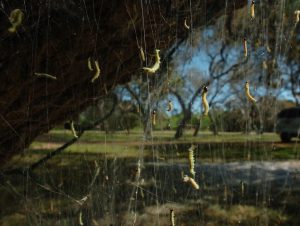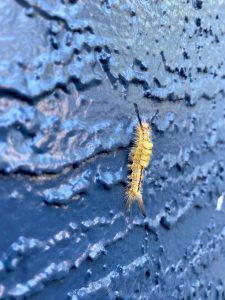Did someone turn on the caterpillar switch?! They are everywhere! It’s that time of year when caterpillars are hatching from their eggs and making their presence known. I’m sure I’m not alone in this experience, but let me share a quick story.

Just last week, I went for a walk around a local pond with my daughter. As we were approaching the pond, we looked up into what could have been a scene from Avatar (a movie about a fantastic alien land). There were hundreds of silks strings tipped with squirming green caterpillars dangling down from a large oak tree. We had to walk through them to get to the pond, and as you can imagine, the webs and caterpillars got all over us. After lots of giggling and breaking through the mass of silk, we did a “caterpillar check” to see who had them on their body. It was quite an experience I’m sure she won’t forget. Okay, so now, what you really what to know…what are these caterpillars?!
There are two main types of caterpillars that do this: leafrollers and leaftiers. The common name of leafroller is a good description of what they do; they roll leaves. They will roll up a leaf and hold it together with silk and then use that little space to feed safely. Leaftiers will pull several different leaves together, bind them with silk, and then feed between the leaves. Both species “balloon” or drift down from the tree on silk strands to reach the ground where their goal is to pupate…that is…if they don’t get eaten first. Fear not, this whole process is short-lived and will be over in a couple of weeks. If you want to learn more about these arboreal acrobats, click here, and if you want to learn about another species of caterpillars you are likely encountering right now, read on…

The next day, we walked past a large building painted a deep blue that we have passed hundreds of times before, but this time we noticed something different. My daughter said, “Mommy! Look!” and pointed out dozens of very, hairy caterpillars scattered along the wall. These scary looking tussock moth caterpillars covered the wall with their beige cocoons lined just under a little ridge at the top. I told her not to touch them…a good rule of thumb for any caterpillar…and then we continued our journey. But, for you, I’m going to continue our learning journey to tell you more about these awesome caterpillars.
In addition to tussock moths being incredibly interesting to look at, their life history is equally fascinating. If you couldn’t tell by how they look, it is best not to touch these caterpillars. Their hairs, especially the four larger tufts of hairs, are known for causing itchy dermatitis and possible welts on skin. Beneath the stiff hairs lies a venom gland. Caterpillars must protect themselves somehow, right? The other cool and unique behavior of tussock moths is the adult female will lay her eggs on the same cocoon from which she emerged. That’s because the females are flightless, so they put out a scent (called pheromones) to attract the flying males. Then, they mate, the female will lay her eggs, and cover them with a secretion and some of hairs from her body. The cocoons remain irritating for up to a year, providing a haven for the eggs to develop and hatch. Pretty cool, huh? You can read more about these amazing insects here.
While it is mortifying to most, I hope learning more about these caterpillars puts you a little at ease. Remember, caterpillars play a critical role in the ecosystem, a major source of food for many birds, including our migratory species coming through the state! We have been seeing so many different species of caterpillars lately. Use this time to expand your knowledge and appreciation for some of our hairy or not-so-hairy, squirmy friends.
 15
15
